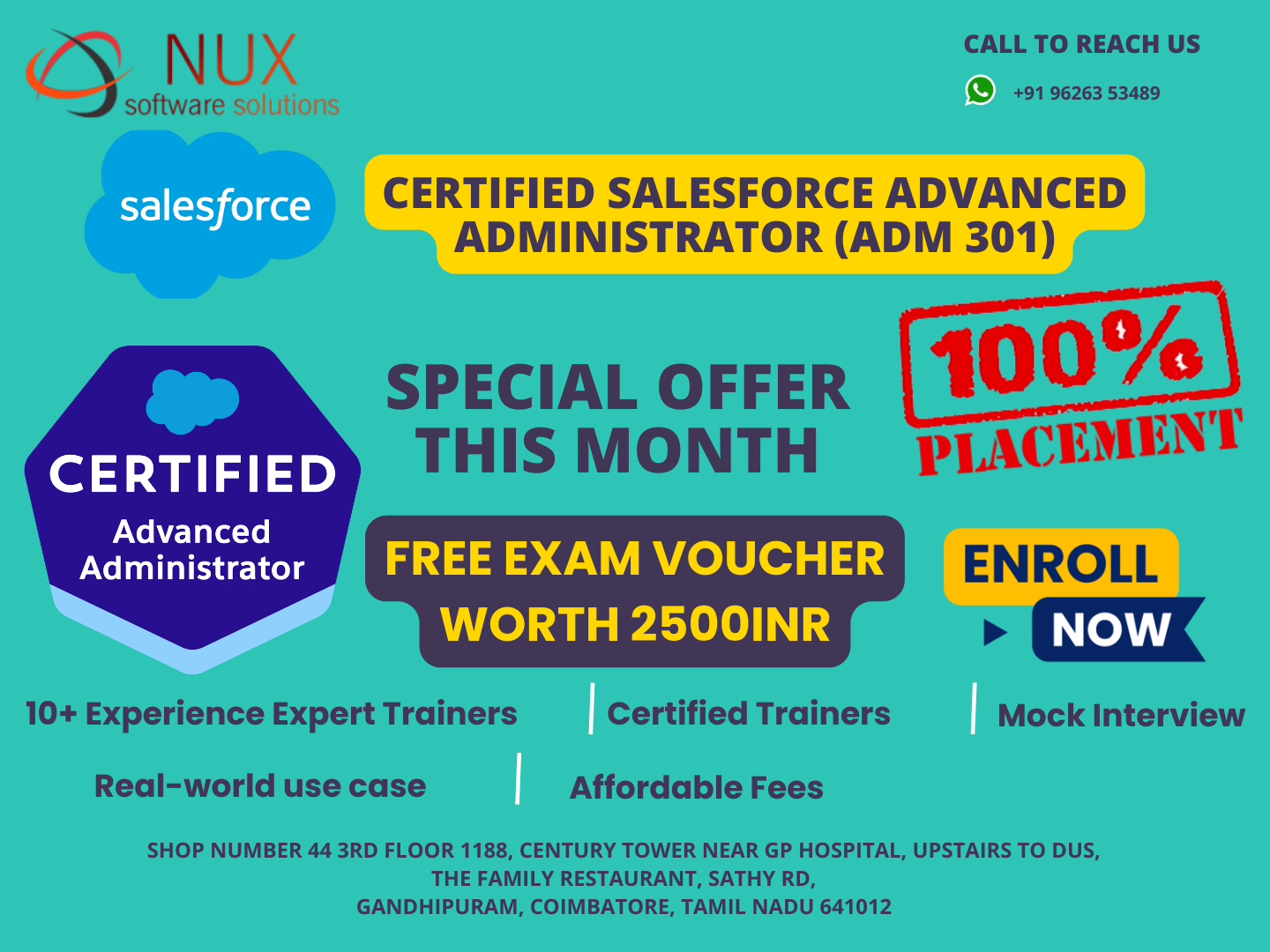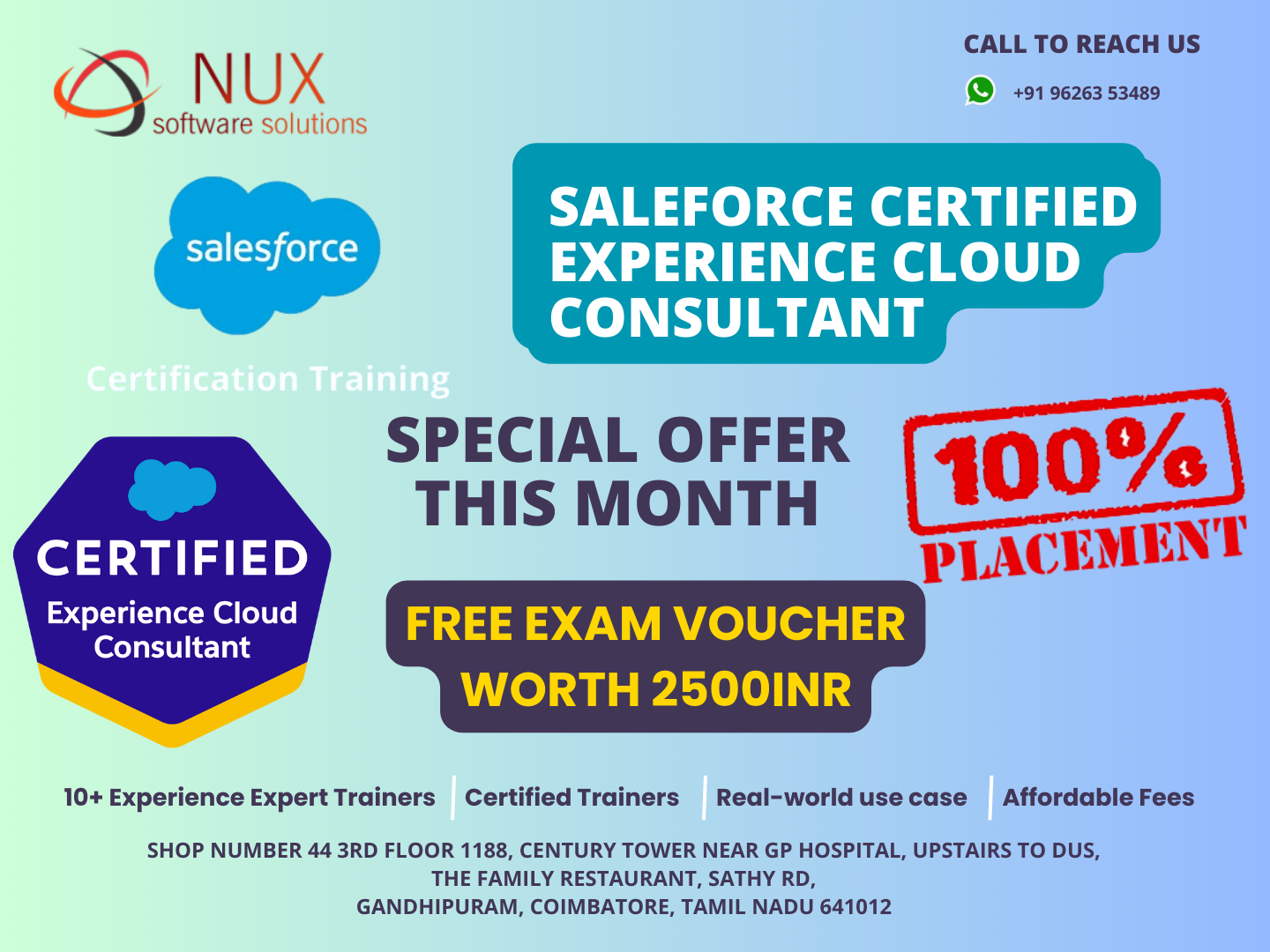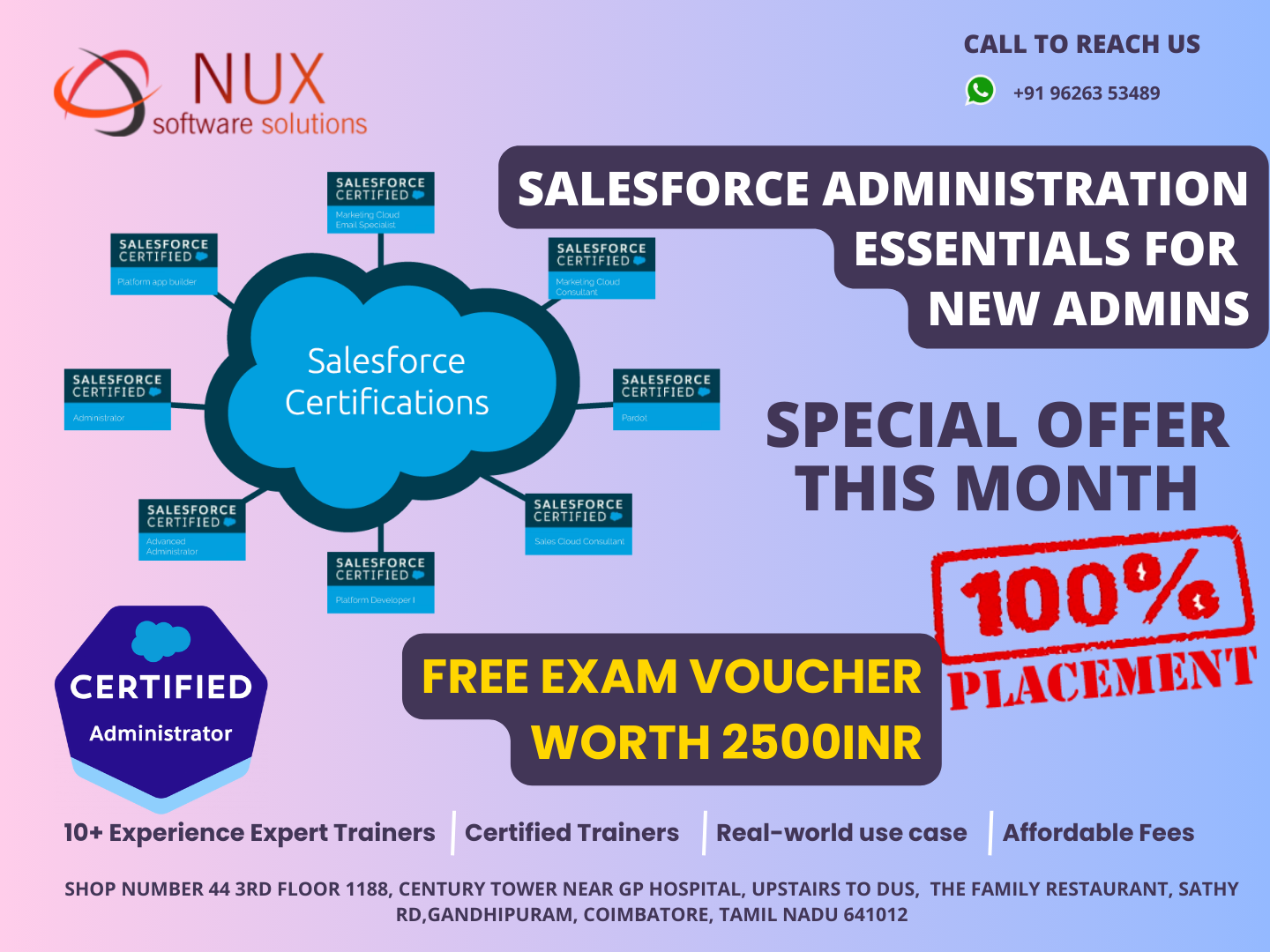Certified Salesforce Advanced Administrator (ADM 301)


Best Certified Salesforce Advanced Administrator (ADM 301) training courses classes deliver by Nux software solutions in coimbatore. Nux software solutions in coimbatore has excellent and advanced training programs that will give you better performance & hands on experience. Our industry’s expert trainers offer a wide range of skills and experience in their graded areas.
The Training center environment is too good for professional, individual, corporate, live project training and industrial training. Labs infrastructure is advanced, well managed and you can access LAB 24X7 from anywhere. Training center has international expert trainers and they have excellent knowledge, real time industry experience.
Our Training programs combine with several innovative learning methods and delivery models. We understand your requirement and it will give you 100 percent growth for your career and provide the cost effective training programs and also work with flexibility for the trainees.
The Salesforce Administrator credential is designed for those who have experience with Salesforce and continuously look for ways to assist their companies in getting even more from additional features and capabilities.
Course Syllabus
Module 1
Lesson 01
1.0 Salesforce Overview
1.1 Introduction to Salesforce
1.2 Salesforce Overview
1.3 Introduction to Salesforce
1.4 Salesforce Editions
1.5 Home Page Customization
1.6 User Management
1.7 Creating and Customizing Tabs
1.8 Creating an App
1.9 Uploading a Company Logo
1.10 Company Information Page
1.11 System Overview Page
1.12 Updating the Fiscal Year
1.13 Quiz
1.14 Case Study
1.15 Case Study Demo
1.16 Key Takeaways
1.17 Conclusion
Module 2
2.1 Introduction to Sales Cloud
2.2 Sales Cloud
2.3 Leads Home Page
2.4 Creating List Views
2.5 Creating and Converting Leads
2.6 Creating Accounts
2.7 Creating Contacts
2.8 Creating Email Templates
2.9 Sending Individual Emails
2.10 Sending Mass Emails
2.11 Creating and Managing Price Books
2.12 Creating Product
2.13 Creating Opportunities
2.14 Creating Activities
2.15 Creating a Web-to-Lead Form
2.16 Creating a Lead Assignment Rule
2.17 Creating a Lead Queue
2.18 Creating an Auto-Response Rule
2.19 Creating Campaigns
2.20 Record Types
2.21 Conclusion
Module 3
3.1 Introduction to Quote Templates
3.2 Quote Templates
3.3 Creating a Quote Record
3.4 Creating a Quote Template
3.5 Generating a Quote PDf
3.6 Emailing a Quote PDF
3.7 Modifying Quote Templates
3.8 Conclusion
Module 4
4.1 Introduction to Service Cloud
4.2 Service Cloud
4.3 Creating Cases
4.4 Creating Case Assignment Rules
4.5 Creating Case Escalation Rules
4.6 Enabling Solutions
4.7 Creating Solutions
4.8 Attaching Solutions to Cases
4.9 Enabling Knowledge
4.10 Configuring Knowledge
4.11 Creating a Web-to-Case Form
4.12 Creating an Email-to-Case Address
4.13 Conclusion
Module 5
5.1 Introduction to AppExchange
5.2 AppExchange
5.3 AppExchange Overview
5.4 Finding and Selecting an App
5.5 Finding a Developer
5.6 Finding a Consultant
5.7 Conclusion
Module 6
6.1 Introduction to Reports
6.2 Reports
6.3 Understanding Report Formats
6.4 Creating a Leads Report
6.5 Creating Contacts and Accounts Report
6.6 Creating an Opportunity Report
6.7 Adding Leads to a Campaign from a Report
6.8 Creating a Report Chart
6.9 Scheduling Reports
6.10 Creating a Campaign Report
6.11 Summarizing Report
6.12 Creating a Report Formula
6.13 Exporting Reports to Excel
6.14 Conclusion
Module 7
7.1 Introduction to Dashboards
7.2 Dashboards
7.3 Understanding Dashboard Components
7.4 Creating a Dashboard
7.5 Refreshing a Dashboard
7.6 Modifying Columns on Dashboards
7.7 Adding Filter to Dashboard
7.8 Managing Access to Reports
7.9 Adding a Report as a Dashboard Component
7.10 Setting Up Dynamic Dashboards
7.11 Enabling Dashboards for iPad
7.12 Modifying Report and Dashboard Interfaces
7.13 Activating the Report Builder on Profiles
7.14 Conclusion
Module 8
8.1 Introduction to Chatter
8.2 Chatter
8.3 Chatter Overview
8.4 Enabling Chatter
8.5 Enabling Chatter Feeds on Records
8.6 Configuring Chatter Groups
8.7 Creating Customer Groups
8.8 Creating a Free Customer Chatter User
8.9 Customizing Chatter Email Notifications
8.10 Configuring Salesforce to Salesforce
8.11 Accepting a Salesforce Connection
8.12 Sharing an Account via Salesforce to Salesforce
8.13 Enabling Ideas
8.14 Configuring Ideas Themes
8.15 Enabling Social Accounts
8.16 Enabling Libraries and Content
8.17 Customizing Libraries and Content
8.18 Uploading Documents to Libraries and Content
8.19 Configuring Salesforce
8.20 Conclusion
Module 9
Lesson 09
9.0 Role Hierarchy
9.1 Introduction to Role Hierarchy
9.2 Role Hierarchy
9.3 Viewing Role Hierarchy
9.4 Creating Roles
9.5 Enabling Field History
9.6 Creating Groups
9.7 Creating Permission Sets
9.8 Assigning Roles to Users
9.9 Conclusion
Module 10
10.1 Introduction to Security Control
10.2 Security Control
10.3 Viewing Object Security
10.4 Changing Default Record Access
10.5 Sharing Settings
10.6 Field Accessibility
10.7 Password Policies
10.8 Session Settings
10.9 Login Flows
10.10 Network Access
10.11 Activations
10.12 Session Management
10.13 Login Access Policies
10.14 Certificate and Key Management
10.15 Viewing Setup Audit Trail
10.16 Executing Expire All Passwords
10.17 Delegated Administration
10.18 Remote Site Settings
10.19 Named Credentials
10.20 File Upload and Download Security
10.21 Conclusion
Module 11
11.1 Introduction to Profiles
11.2 Profiles
11.3 Standard Profiles Overview
11.4 Assigning Page Layouts
11.5 Field-Level Security
11.6 Custom App Settings and Access
11.7 Tab Settings
11.8 Record Type Settings
11.9 Administrative Permission
11.10 General User Permissions
11.11 Standard Object Permissions
11.12 Custom Object Permissions
11.13 Password Policies and Session Timeout
11.14 Login Hours and IP Ranges
11.15 Enabling Apex and Visualforce Access
11.16 Quiz
11.17 Case Study
11.18 Case Study Demo
11.19 Key Takeaways
11.20 Conclusion
Module 12
12.1 Introduction to Data Management
12.2 Data Management
12.3 Importing Leads
12.4 Importing Contacts and Accounts
12.5 Using Mass Delete
12.6 Installing Data Loader
12.7 Importing Records with Data Loader
12.8 Updating Records with Data Loader
12.9 Deleting Records with Data Loader
12.10 Exporting Records with Data Loader
12.11 Adding a Field in the Schema Builder
12.12 Scheduling a Data Export
12.13 Creating and Using Sandbox
12.14 Mass Transferring Records
12.15 Reporting Snapshots
12.16 Working with Tags
12.17 Conclusion
Module 13
13.1 Introduction to Workflow Rules
13.2 Workflow Rules
13.3 Creating a Workflow Rule
13.4 Creating a Workflow Rule Field Update
13.5 Creating a Workflow Rule Task Assignment
13.6 Creating a Workflow Rule Email Alert
13.7 Quiz
13.8 Case Study 1
13.9 Case Study Demo
13.10 Case Study 2
13.11 Case Study Demo
13.12 Key Takeaways
13.13 Conclusion
Module 14
14.1 Introduction to Change Sets and Deployment
14.2 Change Sets and Deployment
14.3 Outbound Change Sets
14.4 Inbound Change Sets
14.5 Deployment Settings
14.6 Deployment Status
14.7 Eclipse IDE
14.8 Quiz
14.9 Case Study
14.10 Case Study Demo
14.11 Key Takeaways
14.12 Conclusion


